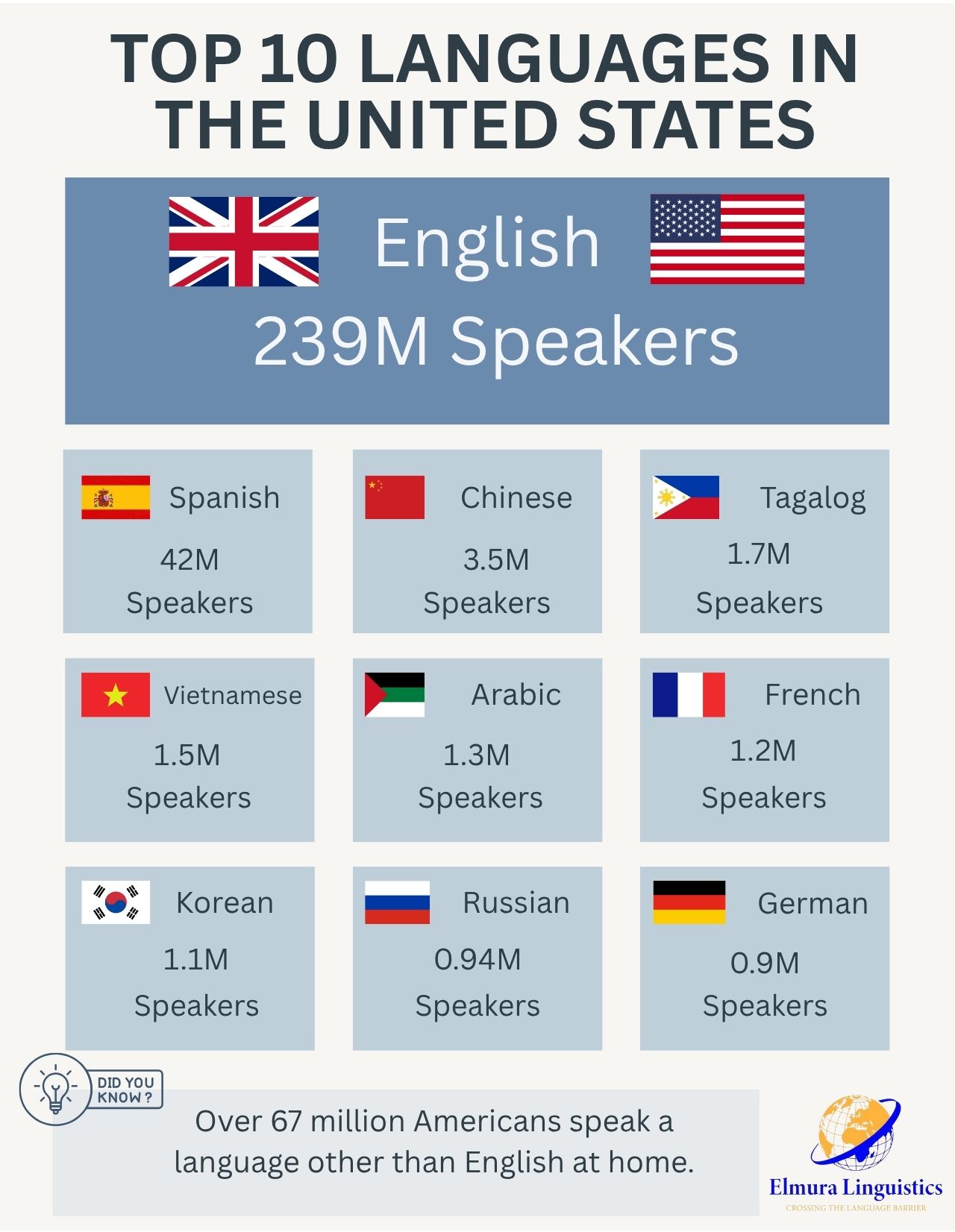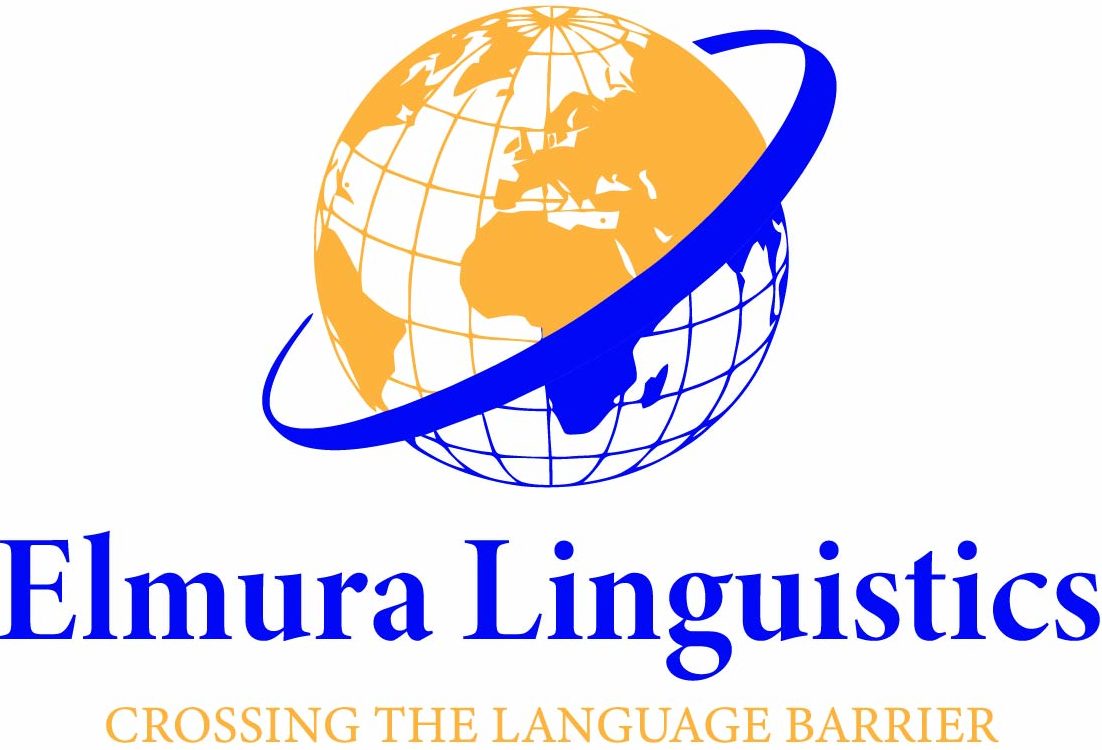According to the U.S. Census Bureau, more than 350 languages are spoken or signed in the United States. Some linguistic surveys report that the number may be closer to 430, depending on how dialects and regional varieties are counted.
English is the primary language for the majority of the population, but millions of residents use another language at home. Spanish is the most common non-English language, followed by Chinese, Tagalog, Vietnamese, Arabic, and French. The number of multilingual households continues to grow as immigration and heritage language retention increase.
This article examines the major languages used in the United States, provides key facts about each, and outlines the broader range of languages that contribute to the country’s linguistic diversity.
The following section outlines the most widely spoken languages based on census data.
Table of Contents
ToggleMajor Languages in the United States
According to U.S. Census Bureau and American Community Survey data, English remains the dominant language, but tens of millions of residents speak another language at home. Below are the ten most widely used languages in the United States, with key facts about each.

English – 239 million speakers
English functions as the common language in public life and administration. It is used in nearly all formal communication, schooling, and legislation. Despite its dominance, multilingualism continues to rise in U.S. households.
- Speakers: Over 239 million (about 78% of the population)
- Primary use: Government, education, business, and media
- Notes: English is not officially designated at the federal level, though most states have adopted it as their official language.
Spanish – 42 million speakers
Spanish has a strong presence across the Southwest and major cities such as Los Angeles, Miami, and New York. It is taught widely in schools and used in public services, broadcasting, and commerce.
- Speakers: About 42 million native and fluent speakers
- Primary use: Everyday communication, business, education, and media in bilingual regions
- Notes: Spanish is the largest non-English language and continues to grow through immigration and intergenerational use.
Chinese (Mandarin and Cantonese) – 3.5 million speakers
Chinese languages are most common in California and New York. Mandarin has grown with new immigration, while Cantonese remains strong in long-established Chinese American communities.
- Speakers: Approximately 3.5 million
- Primary use: Community communication, education, business, and cultural activities
- Notes: Includes Mandarin, Cantonese, and other varieties from China and Taiwan.
Tagalog (including Filipino) – 1.7 million speakers
Filipino communities are concentrated in California, Hawaii, and Nevada. Cultural programs, churches, and local media help sustain Tagalog use in second-generation families.
- Speakers: Around 1.7 million
- Primary use: Home and community language among Filipino Americans
- Notes: Tagalog and Filipino are used interchangeably, with high bilingualism in English.
Vietnamese – 1.5 million speakers
Vietnamese speakers arrived largely after the Vietnam War and formed close-knit communities. Vietnamese language schools and local media outlets maintain language skills among younger generations.
- Speakers: About 1.5 million
- Primary use: Home and community settings, religious and business contexts
- Notes: Strongest concentrations in California and Texas.
Arabic – 1.3 million speakers
Arabic-speaking communities are centered in states such as Michigan, Illinois, and California. The number of Arabic speakers has increased with immigration from the Middle East and North Africa.
- Speakers: About 1.3 million
- Primary use: Family communication, religious institutions, and business
- Notes: Includes multiple dialects such as Egyptian, Lebanese, and Iraqi Arabic.
French – 1.2 million speakers
French remains significant in Louisiana, Maine, and Florida. Haitian communities in New York and Miami also contribute to maintaining the language across generations.
- Speakers: Around 1.2 million
- Primary use: Home, education, and community cultural activities
- Notes: Includes both European French and Haitian Creole–influenced varieties.
Korean – 1.1 million speakers
Korean American communities operate newspapers, schools, and churches that promote language preservation. While English proficiency is high, Korean remains widely used in family and cultural settings.
- Speakers: Roughly 1.1 million
- Primary use: Home, community events, business, and religious gatherings
- Notes: Concentrated in California, New York, and Georgia.
Russian – 940,000 speakers
Russian-speaking enclaves exist in New York, California, and the Pacific Northwest. Cultural centers and churches play a key role in maintaining Russian language use.
- Speakers: About 940,000
- Primary use: Home and community use among immigrants from Eastern Europe
- Notes: Spoken by people from Russia, Ukraine, Belarus, and other post-Soviet states.
German – 900,000 speakers
German is still spoken among Amish, Mennonite, and older immigrant communities. Dialects such as Pennsylvania Dutch continue to be passed down in rural areas of Pennsylvania and the Midwest.
- Speakers: Approximately 900,000
- Primary use: Home, religious, and community life in heritage groups
- Notes: Once the most common non-English language in the 19th century.
All the Other Languages: The Long Tail
Beyond the top ten, hundreds of smaller language communities enrich the U.S. linguistic landscape.
Data Sources and Definitions
Information about language use in the United States comes primarily from the U.S. Census Bureau and the American Community Survey (ACS). These surveys record the language spoken at home by individuals aged five and older.
The Census Bureau groups responses into major language families such as Indo-European, Asian and Pacific Island languages, and Other Languages. Within these groups, languages are further identified by name, but dialects and regional variations are sometimes reported together.
Data collection relies on self-reporting, which can undercount smaller or less-known languages. As a result, official totals represent a broad estimate rather than a precise count. The ACS tables are updated periodically to reflect new immigration patterns and community shifts.
Overview of Languages Spoken in the United States
| Category | Approx. Number of Languages | Estimated Speakers (Age 5 and older) | Examples | Key Notes |
| English | 1 | 239 million + | English | Primary language of most residents; used in government, media, and education. |
| Spanish | 1 | 42 million + | Spanish | Largest non-English language; growing in all major regions. |
| Indo-European Languages (other than English and Spanish) | ~60 | 11 million + | French, German, Portuguese, Italian, Russian, Hindi, Urdu | Includes major European and South-Asian languages; steady or slightly increasing usage. |
| Asian and Pacific Island Languages | ~70 | 12 million + | Chinese, Tagalog, Vietnamese, Korean, Japanese, Hmong | Fast-growing group due to immigration from East, Southeast, and South Asia. |
| African and Middle Eastern Languages | ~50 | 3 million + | Arabic, Amharic, Somali, Yoruba, Tigrinya, Persian | Rapidly expanding presence in urban centers such as Minneapolis, Detroit, and Houston. |
| Indigenous (Native American and Alaska Native) Languages | ~175–190 | <400,000 | Navajo, Dakota, Cherokee, Yup’ik, Apache | Most have small speaker populations; subject to revitalization programs. |
| Sign Languages | ~3 | 0.5–1 million | American Sign Language, Hawaiian Sign Language | ASL is the primary sign language; others used regionally. |
| Other / Unclassified Languages | ~20–30 | <1 million | Creoles, pidgins, rare immigrant tongues | Include languages not captured in broad ACS categories. |
Indigenous and Native American Languages

Before European contact, thousands of Indigenous languages were spoken across North America. Today, the number of active Native American languages in the United States is estimated at about 175 to 190, with most having fewer than 1,000 speakers.
The most widely spoken include Navajo, K’iche’, Dakota, Apache, and Cherokee. Navajo alone accounts for more than 170,000 speakers. Many Native communities run revitalization programs, immersion schools, and language documentation projects to preserve their heritage languages.
Immigrant and Heritage Languages
Immigrant languages make up the largest portion of non-English use in the United States. These include dozens of languages from Asia, Africa, Europe, and the Middle East.
Examples include Hindi, Urdu, Gujarati, Persian (Farsi), Punjabi, Turkish, Somali, Tigrinya, Yoruba, Polish, Italian, and Portuguese. African and South Asian languages have shown the fastest growth rates in recent census data, reflecting newer immigration patterns.
In some communities, heritage languages are maintained through cultural schools, weekend classes, and faith-based education. However, language shift toward English is common by the third generation.
Sign Languages
The U.S. is home to several sign languages, most prominently American Sign Language (ASL). ASL is used by an estimated 500,000 to 1 million people as their primary language.
Other sign languages, such as Hawaiian Sign Language and Plains Indian Sign Language, are used by smaller groups or in specific regions. ASL has an established cultural and educational presence, including in schools for the deaf and interpreter training programs.
Regional Variation
Language diversity is not evenly distributed. Major metropolitan areas such as New York City, Los Angeles, Chicago, Houston, and Miami each report residents speaking over 100 different languages.
In contrast, rural regions and small towns are more linguistically homogeneous. Hawaii and Alaska stand out for their unique Indigenous and local languages, such as Hawaiian and Iñupiaq, which have received state recognition.
Language Trends and Future Outlook
Languages such as Spanish, Arabic, Hindi, and Chinese continue to grow due to immigration and community maintenance. At the same time, many Indigenous and heritage languages face decline as English becomes dominant in younger generations.
Government and educational programs focused on bilingual education, translation services, and language preservation have expanded to address these changes. Data collection also continues to improve, offering a more complete picture of linguistic diversity in the U.S.
Education and Language Learning

Schools in multilingual areas work to balance English proficiency with the maintenance of heritage languages. Public programs such as English as a Second Language (ESL) and bilingual education help students from non-English-speaking households succeed academically.
Community and weekend schools, supported by cultural organizations, teach languages such as Chinese, Korean, Arabic, and Hindi to younger generations. Funding and a shortage of qualified bilingual educators remain persistent challenges in expanding these programs.
Public Services and Accessibility
Federal and state agencies are required to provide language access services so residents can understand and use public information. Translation and interpretation are essential in healthcare, legal systems, and emergency communication.
While Spanish, Chinese, and Arabic are well-supported, smaller communities often face barriers due to limited interpreter availability or lack of translated materials. Improving accessibility remains a major goal for equitable public service delivery.
Indigenous Language Preservation
Many Native American and Alaska Native languages have small speaker populations. Current initiatives, including the Native American Languages Act, tribal immersion schools, and documentation projects, aim to preserve them.
Partnerships between tribal governments, universities, and cultural institutions focus on revitalizing daily use of languages such as Navajo, Cherokee, and Yup’ik. Sustained support for community-based education and teacher training is critical to long-term survival.
Immigration and Cultural Identity

Immigrant languages remain central to cultural identity and community cohesion. First-generation immigrants use them to maintain family and cultural ties, while younger generations often shift toward English in education and public life.
Heritage language retention depends increasingly on media, digital communication, and organized cultural programs rather than daily home use. This shift reflects both integration into American society and the gradual loss of linguistic distinctiveness.
Technology and Language Access
Advances in digital tools have expanded communication across language barriers. Automated translation, subtitling, and language-learning applications are now common in education and public services.
However, smaller and endangered languages remain underrepresented in technology platforms. Future development should prioritize inclusivity and accuracy for low-resource languages to prevent further marginalization.
Conclusion
Language diversity in the United States reflects centuries of settlement, migration, and cultural exchange. English remains dominant, but more than 350 languages are spoken or signed nationwide, representing communities from every region of the world.
The data show that multilingualism is a defining characteristic of American society, not an exception. While some languages continue to grow through immigration and intergenerational use, many Indigenous and smaller heritage languages face decline.
Efforts in education, public policy, and technology will shape how this linguistic landscape evolves. Sustaining and documenting the country’s many languages is essential to preserving both cultural heritage and equitable access for all communities.





